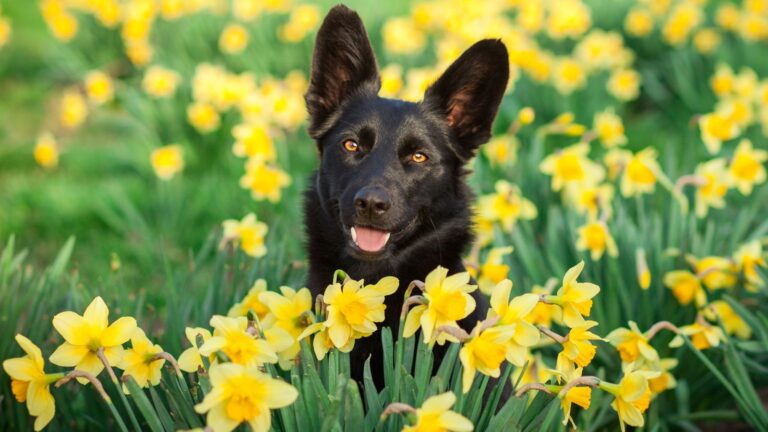There are many outdoor and potted plants can be toxic to dogs. And while most will likely only result in irritated stomachs, some can cause serious health problems if large amounts are ingested. We’ve compiled the few of these common plants that cause the most harm to your dog.
Ricinus

Castor beans, the seed of the ricinus, are highly toxic to dogs. When ingested, they can experience abdominal pain, drooling, vomiting, and diarrhea. Severe poisoning can lead to abdominal pain, seizures, and even death, so urgent veterinary care is essential when dogs eat castor beans.
Daffodil

This yellow-flowered plant contains lycorine, an alkaloid with strong emetic properties that can cause dogs to vomit and drool and suffer from more serious symptoms like convulsions, cardiac arrhythmias, and low blood pressure. The bulbs are the most poisonous part of the plant, so if your dog eats one, ensure you get immediate veterinary attention.
Dieffenbachia (Dumb Cane)

The dumb cane is a popular indoor plant known for its vibrant green color. Wag Walking warns that dogs who enjoy chewing on foliage are at risk of being poisoned by the plant, with symptoms including oral irritation, excessive drooling, vomiting, difficulty swallowing, and temporary vocal cord paralysis.
Oleander

The oleander’s pink flowers make them popular in gardens, but all parts of the plant are toxic to dogs. The plant contains cardiac glycosides that can severely affect a dog’s heart function, but the bitter taste often deters dogs from eating it.
Azalea and Rhododendron

Azaleas and rhododendrons contain grayanotoxins, which can disrupt your dog’s cellular function and can lead to vomiting, diarrhea, weakness, and even cardiac failure in severe cases. Even a few leaves from these plants can make dogs seriously ill, so prompt veterinary intervention is crucial.
Sago Palm

This slow-growing plant is toxic to humans and dogs. VCA Animal Hospitals notes that all parts of this plant are poisonous, but the seeds are the most harmful to dogs. The cycasin in the sago palm can cause severe liver damage and neurological damage to dogs.
Foxglove

These tall plants with tubular-shaped flowers contain cardiac glycosides that are toxic to your dog. Early symptoms after ingestion of the plant may mimic those of digestive upset, which can lead dog owners into a false sense that their dog is okay when they actually could suffer from heart failure and cardiac arrhythmias.
Kalanchoe

Kalanchoe, or widow’s thrill, is a popular potted plant known for its orange and pink flowers. The plant contains bufadienolides, which can lead to vomiting, diarrhea, and heart arrhythmias in dogs hours after ingestion.
Tulip

Tulips are popular for their large, brightly colored flowers, but their bulbs are toxic to dogs. Blue Cross warns that if eaten, they can irritate dogs’ mouths and stomachs. While “most dogs will only experience drooling, sickness, and diarrhea,” heart problems and breathing difficulties are signs of serious tulip poisoning.
Lily of the Valley

Lily of the Valley is infamous for being poisonous to humans, cats, and dogs. It contains cardiac glycosides similar to those in digitalis, and even a small amount of ingested plant material can cause serious health issues for dogs.
Monkshood (Aconitum)

The monkshood is known for its purple flowers. It is highly toxic, containing aconitine, a potent neurotoxin. Ingestion can cause gastrointestinal upset, heart arrhythmias, muscle weakness, and heart paralysis in dogs, so rapid veterinary attention is important.
Morning Glory

Morning glory flowers contain lysergic alkaloids, which can cause gastrointestinal upset, agitation, tremors, disorientation, and ataxia in dogs. The seeds pose the greatest risk and could potentially cause hallucinations, so if your dog ingests them, take them to a vet.
Mountain Laurel

Mountain laurel contains grayanotoxins, which, when ingested by a dog, can lead to drooling, vomiting, diarrhea, weakness, and cardiac issues. This plant is similar in toxicity to rhododendrons and azaleas, so early intervention with veterinary care is critical to preventing more severe outcomes.
Autumn Crocus

This lilac-colored flower contains colchicine, a highly toxic alkaloid. The American College of Veterinary Pharmacists warns that all parts of the plant are poisonous for dogs and that common “signs of toxicity include thirst, difficulty swallowing, abdominal pain, vomiting, diarrhea, weakness, and shock.”
Peace Lily

This popular potted plant contains calcium oxalate crystals, which cause oral irritation, pain, excessive drooling, vomiting, and difficulty swallowing when ingested by dogs. Although this plant isn’t as toxic as others, its symptoms can still be distressing for dogs.
Philodendron

Philodendrons are one of the most common houseplants and contain insoluble calcium oxalates, which pose a risk to dogs. Ingesting part of the philodendron leaf can cause oral pain, drooling, vomiting, and difficulty swallowing.
Yew

The yew is known for its distinctive red seeds and can grow into a large tree. All parts of the yew are toxic and contain taxine, a compound that can cause central nervous system damage, breathing difficulties, dilated pupils, and life-threatening changes in heart rate in dogs.
Hydrangea

Hydrangeas are a popular choice for gardens but contain cyanogenic glycosides, which release cyanide when chewed, leading to potential oxygen deprivation at the cellular level. Although it is rarely fatal, dogs ingesting hydrangeas should prompt a call to the vet for advice on monitoring and care.

